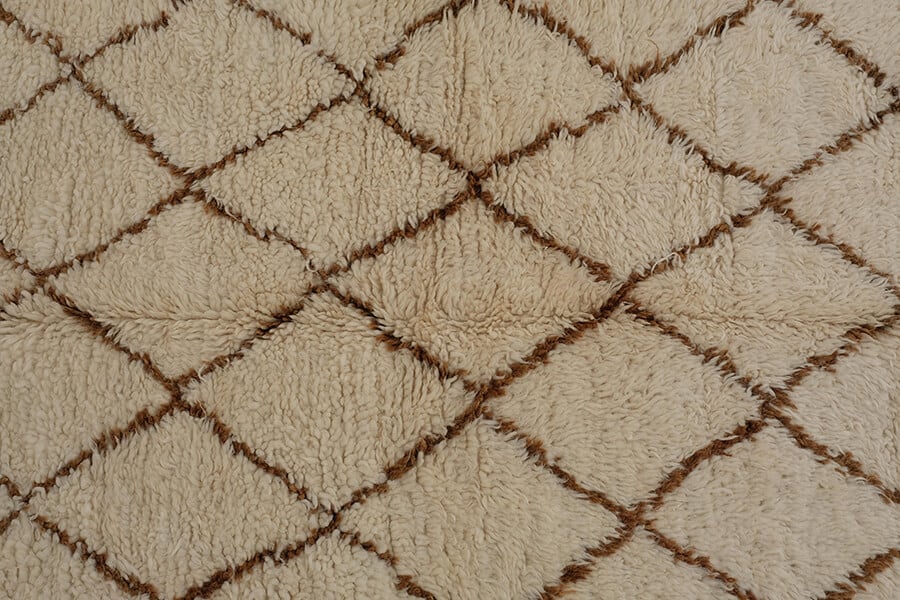Top Moroccan Rug Patterns
When you walk around the souks of Marrakech Medina, you find the best of local artisanship. Among the touristic magnets and the spices, you will find unique pieces.
Moroccan rugs fill the shops of the souk. They are up on the walls, down on the floor, and stacked in the front. They are not just souvenirs, they are stories.
The history of handmade Moroccan rugs
The tradition of rugs in Morocco is as ancient as time. It started with the Berbes, the original inhabitants of the country. They’ve used knotted and flat-woven carpets that doubled as bed coverings and sleeping mats. They were shepherds and farmers who needed comfortable and flexible carpets.
Depending on the location of the weavers, the rugs had different patterns and consistency.
In the Atlas Mountains, the temperatures can be unforgiving and snow is common. So, rugs in this region are thick and they have a heavy pile, perfect to protect from the weather. In the Sahara desert, the climate is the opposite. Here, the Moroccan rugs are lighter and flat woven to create a fresh space.
Every region has its traditions and patterns, which reflect the local heritage.
The types of Moroccan rugs +++
The Berbers played a major role in the fame and spread of this tradition. Since they moved from area to area, they left their heritage behind.
The Boucherouite Moroccan rug
When women started weaving for decoration instead of domestic use, they created non-traditional styles. These handmade Boucherouite carpets are made from scraps. They are leftover pieces of wool, leather, or cotton, so these rugs are sustainable.
They have bright colors and asymmetrical patterns. Since they were once used as tunics or clothing items, the handmade Boucherouite Moroccan rugs are combined with the weaver’s intuition and imagination. They often follow the patterns of tribes, like the chevron symbol. It’s a zigzag pattern that creates almost an optical illusion.
The Kilim Moroccan rug
The kilim is its own special type of carpet. They are decorative, but they can also be used for prayer. What makes them unique and prestigious is the weaving technique. It’s a long and detailed work, 100 percent handmade.
The artisans often use wool and dyes to create a colorful, thin, and decorative rug. The patterns of this type of Moroccan rug include Elibelinde, a stylized woman. Or the amulet, a triangle shape, that represents protection and good luck. Even the colors change based on the region. For example, weavers in the south of Morocco prefer bright shades, like yellow.
The Beni Ourain Moroccan rug
Straight from the homonymous region in the Atlas Mountains, these handmade Moroccan carpets are masterpieces. They were born to protect Berber tribes against the winters. They covered the hut’s floors, almost like an insulation layer. They were small rugs, designed to be comfortable to carry around.
They are unique because Beni Ourain rugs are made 100 percent of sheep wool and they are 100 percent naturally dyed. Realizing one takes hours of sweat -sometimes even days. They are warm and they’ve become luxurious, the product of true artisanship. They mainly feature geometric patterns, instead of tribal symbols.
The Azilal Moroccan rug
These carpets come from the center of Morocco, from an area of mountains and waterfalls. The base of these handmade rugs is a creamy and light color, often white. Above it, the weavers go wild with bright colors and patterns.
They were born for domestic use, to be warm and comfortable. They are made of wool and or cotton, and each one tells the story of the artisan. The Azilal rugs come from Berber traditions and the world is learning to appreciate them. Since they’ve become difficult to find, their vibrant colors are appreciated everywhere.
The Moroccan Shag rug
More than a regional carpet, this is a style choice. These rugs are considered vintage. They feature both classic tribal designs and a modern aesthetic. The pattern is often minimal and they are power-loomed. Thanks to a blend of synthetic yarns and continual class, these carpets are luxurious.
The Moroccan Shag rugs don’t have any Berber or tribal heritage. They are the result of passionate weavers.
The patterns of Moroccan rugs +++
Most of the design is up to the weaver’s imagination, but these are the most famous patterns:
-
- Geometric can include all shapes
- Trellis, which reminds you of the garden
- Tribal symbols, with all their different meanings
- Abstract designs, with a story behind the shape
- Diamonds, for the lady
While they all tell a story, the choice is up to you. Depending on your taste, you will choose the perfect handmade Moroccan rug.
Styling Moroccan Rugs
Choosing the right carpet for your style and needs might be difficult. Here are a few tips to make the right choice for you. Let’s start with use.
- Area rugs are more decorative, a piece of interior design
- Outdoor rugs need to be thicker and stronger
- Moroccan runner rugs are longer, rather than wider. They are perfect to decorate hallways
- Bath rugs are designed to absorb water and to keep your feet dry
There is only one rule when you pick a Moroccan rug: don’t use the decorative ones for domestic use. Other than that, follow your inspiration. The handmade rugs from Morocco have tons of it.

